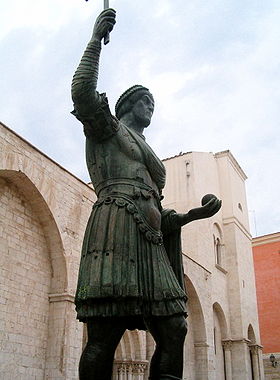
Colossus of Barletta
Encyclopedia

Barletta
Barletta is a city and comune located in the north of Apulia in south eastern Italy. Its current population is 94,140.It is famous for the Colossus of Barletta, a bronze statue, representing a Roman Emperor...
, Italy
Italy
Italy , officially the Italian Republic languages]] under the European Charter for Regional or Minority Languages. In each of these, Italy's official name is as follows:;;;;;;;;), is a unitary parliamentary republic in South-Central Europe. To the north it borders France, Switzerland, Austria and...
.
The statue reportedly washed up on a shore, after a Venetian ship sank returning from the sack of Constantinople
Constantinople
Constantinople was the capital of the Roman, Eastern Roman, Byzantine, Latin, and Ottoman Empires. Throughout most of the Middle Ages, Constantinople was Europe's largest and wealthiest city.-Names:...
in the Fourth Crusade
Fourth Crusade
The Fourth Crusade was originally intended to conquer Muslim-controlled Jerusalem by means of an invasion through Egypt. Instead, in April 1204, the Crusaders of Western Europe invaded and conquered the Christian city of Constantinople, capital of the Eastern Roman Empire...
in 1204. The identity of the Emperor is uncertain. According to tradition, it depicts Heraclius
Heraclius
Heraclius was Byzantine Emperor from 610 to 641.He was responsible for introducing Greek as the empire's official language. His rise to power began in 608, when he and his father, Heraclius the Elder, the exarch of Africa, successfully led a revolt against the unpopular usurper Phocas.Heraclius'...
(reign 610-641 AD); though this is most unlikely on historical and art-historical grounds. More likely subjects are Theodosius II
Theodosius II
Theodosius II , commonly surnamed Theodosius the Younger, or Theodosius the Calligrapher, was Byzantine Emperor from 408 to 450. He is mostly known for promulgating the Theodosian law code, and for the construction of the Theodosian Walls of Constantinople...
(reign 408-450 AD), who may have had it erected in Ravenna
Ravenna
Ravenna is the capital city of the Province of Ravenna in the Emilia-Romagna region of Italy and the second largest comune in Italy by land area, although, at , it is little more than half the size of the largest comune, Rome...
in 439, Honorius
Honorius (emperor)
Honorius , was Western Roman Emperor from 395 to 423. He was the younger son of emperor Theodosius I and his first wife Aelia Flaccilla, and brother of the eastern emperor Arcadius....
(reign 393-423 AD), Valentinian I
Valentinian I
Valentinian I , also known as Valentinian the Great, was Roman emperor from 364 to 375. Upon becoming emperor he made his brother Valens his co-emperor, giving him rule of the eastern provinces while Valentinian retained the west....
(r. 364-375), Marcian
Marcian
Marcian was Byzantine Emperor from 450 to 457. Marcian's rule marked a recovery of the Eastern Empire, which the Emperor protected from external menaces and reformed economically and financially...
(r.450-457) or Justinian I
Justinian I
Justinian I ; , ; 483– 13 or 14 November 565), commonly known as Justinian the Great, was Byzantine Emperor from 527 to 565. During his reign, Justinian sought to revive the Empire's greatness and reconquer the lost western half of the classical Roman Empire.One of the most important figures of...
(r.527-565).
It is known that a colossal statue was discovered in 1231-1232 during excavations commissioned by Emperor Frederick II
Frederick II, Holy Roman Emperor
Frederick II , was one of the most powerful Holy Roman Emperors of the Middle Ages and head of the House of Hohenstaufen. His political and cultural ambitions, based in Sicily and stretching through Italy to Germany, and even to Jerusalem, were enormous...
in Ravenna, and is probable that he had it transported to his southern Italian lands. The first certain news about the statue date however from 1309, when parts of its legs and arms were used by local Dominicans to cast bells. The missing parts were remade in the 15th century.
The statue evidently depicts an emperor, identifiable from his imperial diadem
Diadem (personal wear)
A diadem is a type of crown, specifically an ornamental headband worn by Eastern monarchs and others as a badge of royalty. The word derives from the Greek "διάδημα" , "band" or "fillet", from "διαδέω" , "I bind round", or "I fasten"....
and his commanding gesture that invokes the act of delivering a speech, with his right arm raised, holding a cross. The Emperor wears a cuirass
Cuirass
A cuirass is a piece of armour, formed of a single or multiple pieces of metal or other rigid material, which covers the front of the torso...
over his short tunic. His cloak is draped over his left arm in a portrait convention that goes back to Augustus
Augustus
Augustus ;23 September 63 BC – 19 August AD 14) is considered the first emperor of the Roman Empire, which he ruled alone from 27 BC until his death in 14 AD.The dates of his rule are contemporary dates; Augustus lived under two calendars, the Roman Republican until 45 BC, and the Julian...
. In his outstretched left hand he now holds an orb
Globus cruciger
The globus cruciger is an orb topped with a cross , a Christian symbol of authority used throughout the Middle Ages and even today on coins, iconography and royal regalia...
. His diademed head wears a Gothic
Goths
The Goths were an East Germanic tribe of Scandinavian origin whose two branches, the Visigoths and the Ostrogoths, played an important role in the fall of the Roman Empire and the emergence of Medieval Europe....
jewel, similar to the one worn by Aelia Eudoxia
Aelia Eudoxia
Aelia Eudoxia was the Empress consort of the Byzantine Emperor Arcadius.-Family:She was a daughter of Flavius Bauto, a Romanised Frank who served as magister militum in the Western Roman army during the 380s. The identity of her father is mentioned by Philostorgius...
, mother of Theodosius II.
Further reading
- Tomi Di Paola. The Mysterious Giant of Barletta: An Italian Folktale (Voyager Books) (ISBN - 0152563490)

